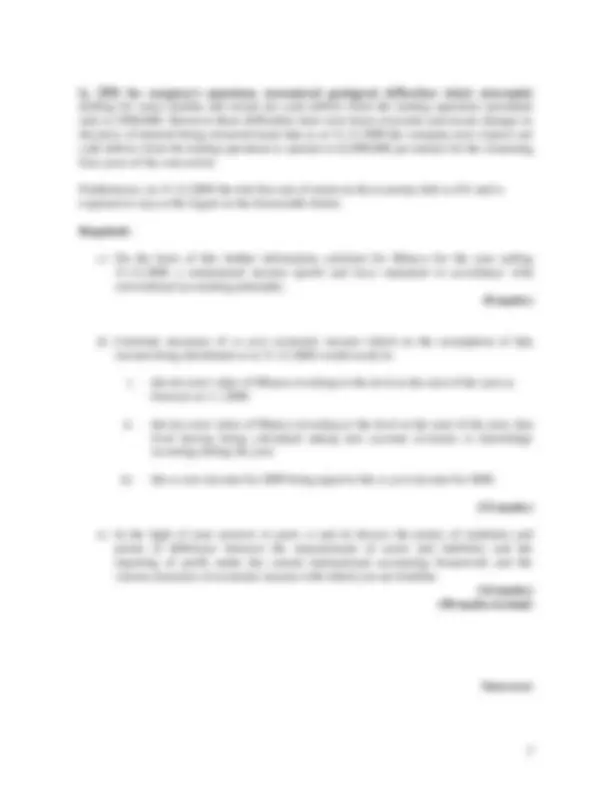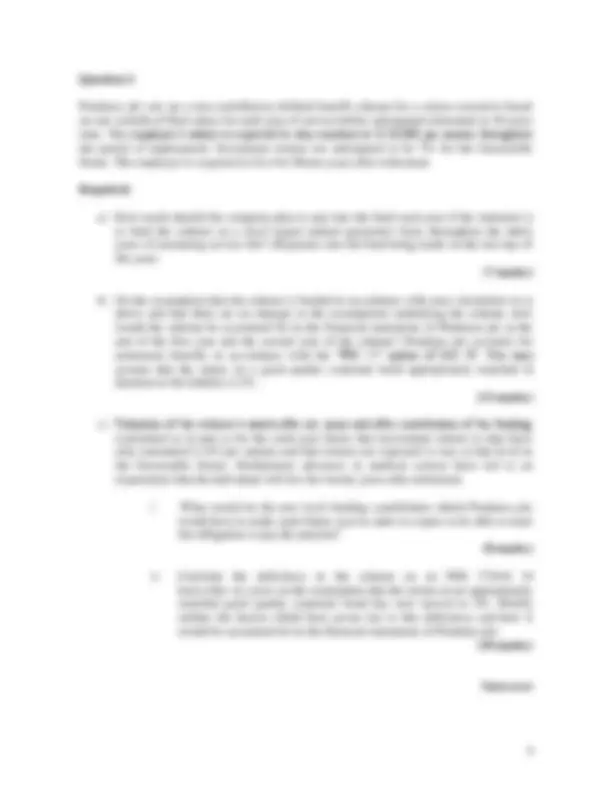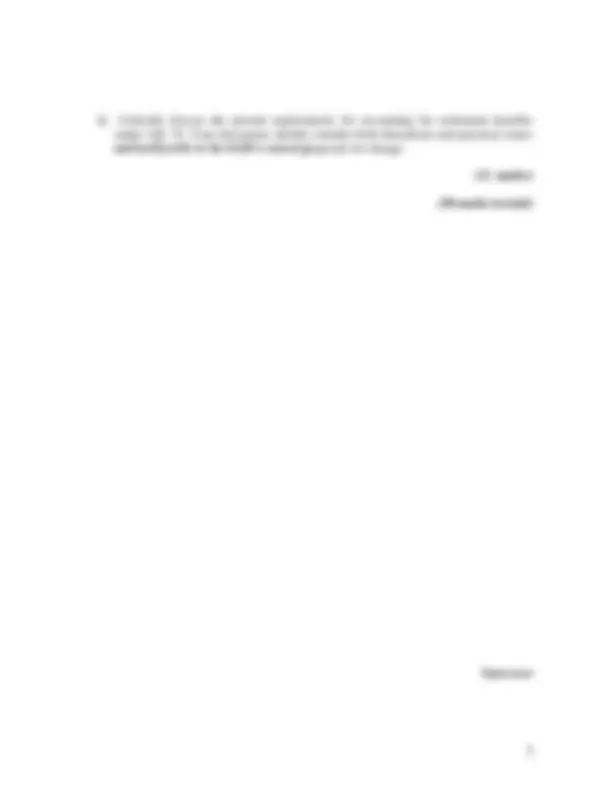





Study with the several resources on Docsity

Earn points by helping other students or get them with a premium plan


Prepare for your exams
Study with the several resources on Docsity

Earn points to download
Earn points by helping other students or get them with a premium plan
Community
Ask the community for help and clear up your study doubts
Discover the best universities in your country according to Docsity users
Free resources
Download our free guides on studying techniques, anxiety management strategies, and thesis advice from Docsity tutors
Information and questions from an advanced financial accounting exam held at prifysgol aberystwyth university in january 2009. The exam covers various accounting topics including constructing a summarised opening balance sheet, calculating economic income, and accounting for retirement benefits. The document also includes questions on the impact of changes in assumptions on funding requirements and the discussion of the present requirements for accounting for retirement benefits under ias 19.
Typology: Exams
1 / 7

This page cannot be seen from the preview
Don't miss anything!




DEGREE EXAMINATIONS – January 2009 ARHOLIADAU GRADD – Ionawr 2009
Time allowed: THREE hours
Answer FOUR questions – all questions have equal marks.
Each question is worth a maximum of 50 marks.
Casio FX83ES or FX85ES calculators only may be used.
You will be supplied with: Statistical Tables for Economic, Business and Social Studies.
Turn over
Question 1
Mineco is a company which as at 1.1.2008 holds the following assets:
An irredeemable government security paying 6% per annum on a nominal value of £12,000,000. This security is accounted for on a mark to market basis with any gains or losses being taken through the income statement.
Rights in respect to the exploitation of a mineral concession. These rights have five years left to expiry and currently generate net cash inflows of £1,900,000 per annum. It is expected that these inflows will continue at this level for the next five years. These rights were acquired on 1.1.2003 for £10,000,000. They have no residual value and are being depreciated/amortised on a straight line basis over their lifetime.
Drilling equipment also purchased on 1.1.2003. This equipment which cost £4,000,000 has a ten year life expectancy and a zero residual (scrap) value. It is being depreciated on a straight- line basis.
Mineco is financed by £2,000,000 ordinary share capital and a £10,000,000 loan issued at par on which interest is payable at 8% per annum. This loan is repayable at its par (nominal) value in four years time.
There are no other assets and liabilities as at 1.1.2008.
The risk free rate of return in the economy is 10% and is expected to stay at this figure in the foreseeable future. Mineco can borrow and invest at this rate of return.
You may assume that all cash flows occur on the last day of the year to which they relate and that there is no taxation in the economy.
Required :
On the basis of this information:
a) Construct for Mineco a summarised opening balance sheet as at 1.1.2008 in accordance with conventional accounting principles (treat the difference between net assets and share capital as distributable reserves). (8 marks)
b) Calculate for Mineco a measure of ex ante economic (Hicksian) income for the year ending 31.12.2008. (8 marks)
Turn over
Question 2
Prudence plc sets up a non-contributory defined benefit scheme for a senior executive based on one sixtieth of final salary for each year of service before anticipated retirement in 30 years time. The employee’s salary is expected to stay constant at £120,000 per annum throughout the period of employment. Investment returns are anticipated to be 7% for the foreseeable future. The employee is expected to live for fifteen years after retirement.
Required:
a) How much should the company plan to pay into the fund each year if the intention is to fund the scheme on a level (equal annual payments) basis throughout the thirty years of remaining service life? (Payments into the fund being made on the last day of the year). (7 marks)
b) On the assumption that the scheme is funded in accordance with your calculation in a) above and that there are no changes to the assumptions underlying the scheme, how would the scheme be accounted for in the financial statements of Prudence plc at the end of the first year and the second year of the scheme? Prudence plc accounts for retirement benefits in accordance with the ‘FRS 17’ option of IAS 19. You may assume that the return on a good quality corporate bond appropriately matched in duration to the liability is 5%. (13 marks)
c) Valuation of the scheme’s assets after six years and after contribution of the funding (calculated as in part a) for the sixth year shows that investment returns to date have only amounted to 6% per annum and that returns are expected to stay at that level in the foreseeable future. Furthermore advances in medical science have led to an expectation that the individual will live for twenty years after retirement.
i What would be the new level funding contribution which Prudence plc would have to make each future year in order to expect to be able to meet the obligation to pay the pension? (8 marks)
ii Calculate the deficiency in the scheme on an FRS 17/IAS 19 basis after six years on the assumption that the return on an appropriately matched good quality corporate bond has now moved to 4%. Briefly outline the factors which have given rise to this deficiency and how it would be accounted for in the financial statements of Prudence plc. (10 marks)
Turn over
d) Critically discuss the present requirements for accounting for retirement benefits under IAS 19. Your discussion should consider both theoretical and practical issues and briefly refer to the IASB’s current proposals for change.
( 12 marks)
(50 marks in total)
Turn over
Question 4
a) Identify what you understand by the term ‘earnings management’ in relation to financial reporting and discuss the range of motivations which might prompt the use of earnings management techniques. (20 marks)
b) Give examples of the manner in which earnings management has been practiced in recent years in the UK and North America briefly considering the manner in which researchers have sought to establish evidence of the existence of earnings management (30 marks)
(50 marks in total)
Question 5
IAS 39 has been seen as opening the possibility for companies to utilise market values in their financial statements and to record relevant gains and losses in their income statements.
a) Set out the present requirements of IAS 39 with regard to the measurement of financial assets and liabilities. (15 marks)
b) Identify what you consider to be the advantages and disadvantages of the widespread use of mark to market accounting giving examples of the manner of its use in practice in cases with which you are familiar, for example Enron.
(35 marks)
(50 marks in total)
End of Paper